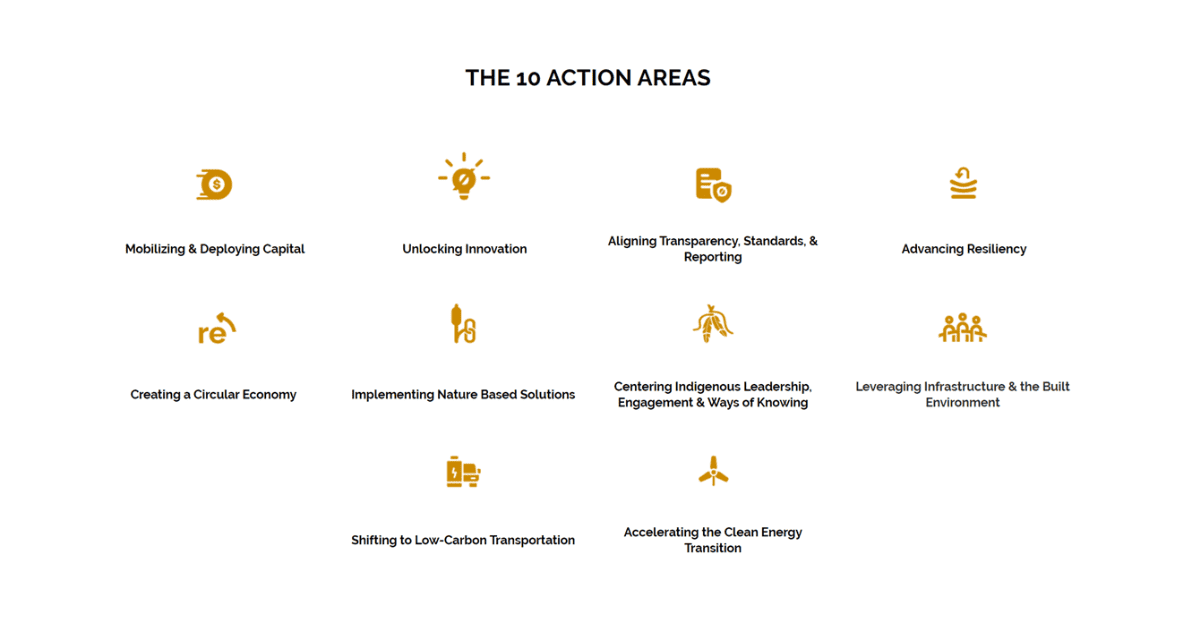
I recently attended the GLOBExCHANGE Conference in Toronto, Canada, which hosted climate and sustainability leaders from across the country. Representatives from the private sector and Canadian government came together to discuss The Path to Net Zero: 10×10 Matrix, which identifies the 10 action areas the world must prioritise in the next decade to achieve net zero by 2050:
- Mobilising and deploying capital
- Unlocking innovation
- Aligning transparency, standards and reporting
- Advancing resiliency
- Creating a circular economy
- Implementing nature-based solutions
- Centering Indigenous leadership, engagement and ways of knowing
- Leveraging infrastructure and the built environment
- Shifting to low-carbon transportation
- Accelerating the clean energy transition
The conference explored the implications of accelerating climate innovation and clean energy transition across various sectors — including transportation, infrastructure, oil and gas, financial, and IT services — at the same time as engaging diverse stakeholder groups.
There was a renewed focus on biodiversity loss throughout, as well as the importance of designing and implementing nature-based solutions to protect, manage and restore natural ecosystems.
Biodiversity garnered mainstream attention at last year’s UN Biodiversity Conference (COP15) in Montreal, Canada. There, just under 190 countries agreed on the landmark Kunming-Montreal Global Biodiversity Framework to halt and reverse nature loss, enabling recovery of the world’s natural capital by 2050. Here are some biodiversity takeaways from this year’s GLOBExCHANGE Conference:
1. Indigenous-led conservation is key
The critical role of Indigenous peoples in protecting nature around the world has long been ignored. However, research by the World Wildlife Fund shows that Indigenous communities protect 80% of Earth’s biodiversity.
Governments and the private sector must draw on the traditional knowledge of Indigenous peoples and support Indigenous-led conservation of natural areas to meet national and global climate and biodiversity goals.
In terms of Canada, conference attendees agreed that Indigenous-led conservation is the most effective and holistic conservation effort in the country. Indigenous rights and reconciliation must remain at the centre of every climate and biodiversity conservation.
There was much discussion on “Etuaptmumk” or two-eyed seeing. This Mi’kmaw approach views the world with one eye through Indigenous ways of knowing, and the other eye through a Western lens. This approach could help governments and industry work with Indigenous communities to address the pressing biodiversity challenges.
2. Going from framework to action
Without clear standards for measuring the value of ecosystem services and calculating the risks from biodiversity loss to business value, it will be hard to translate the Global Biodiversity Framework into concrete action. These challenges are further compounded by an absence of biodiversity-related regulations to date, such as mandatory disclosure requirements for the impact of business activity on nature.
However, this may change soon. The Taskforce on Nature-related Financial Disclosures (TNFD) will publish its recommendations in September this year for companies to adopt a risk management and disclosure framework to report on nature-related risks and opportunities. The TNFD framework aims to help organisations of all sizes, in all jurisdictions, to identify, manage and disclose the relationship between their businesses and natural ecosystems. This should provide a good starting point for organisations to integrate biodiversity risks into their strategic and financial decision-making.
3. Integrating biodiversity risks into financial decision-making
A UN Environment Programme report in 2021 estimated that half of the world’s GDP is dependent on nature. The banking sector has a big role to play in measuring natural capital and integrating biodiversity risks into financial decision-making, with challenges and opportunities ahead in prioritising biodiversity action:
- Developing comprehensive reporting and risk assessment tools to integrate biodiversity risks into business strategy, rather than focusing on climate risks alone
- Drawing on external expertise and collaborating with organisations focused on biodiversity work
- Becoming more transparent in identifying and disclosing biodiversity risks in company reports
- Working with the TNFD to integrate nature into decision-making
- Closing the financing gap in biodiversity efforts by directing more capital towards nature-based solutions.
- Investing in innovations in biodiversity technology, such as remote sensing and bioacoustics, that can help organisations get essential data to advance conservation efforts
The Competent Boards Climate and Biodiversity Designation Program helps prepare companies for a low-carbon and nature-positive future by providing an understanding of how to ensure effective board oversight over climate and biodiversity actions. At the same time, the program covers how to respond to the growing biodiversity-related demands from investors and other stakeholders.
Maria Shamim is a research analyst at Competent Boards. Follow Competent Boards on LinkedIn.
Back To News & Views